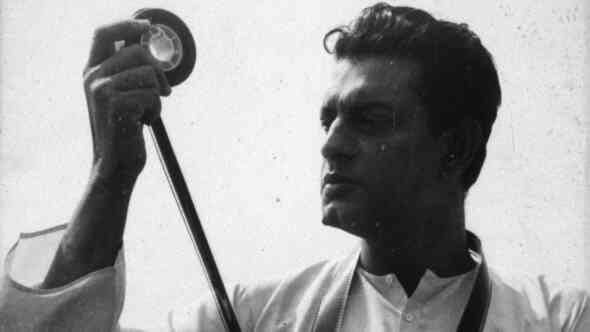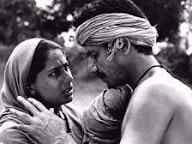
The great maestro’s centenary has finally arrived. As a longtime Ray aficionado I had to contribute something to this. Having watched his films multiple times and read several scholarly works on his cinema by likes of Marie Seton, Andrew Robinson, John Wood, and Chidananda Dasgupta, and read his writings in Bengali as well as English, Ray to me has been nothing less than a colossal figure. Last year in summers we held a small private Ray festival in a small village, that acted as a base for us in the area, called Mohgaon in Mandla district of MP. There were 14 Ray films which a small group of enthusiasts watched on projector and screen.
But what to write on Ray that has already not been written? How can one write without sounding trite and peddling platitudes? So I decided to write a niche piece, on a very small slice in his career, which, I hope will come as considerably fresh and novel to those interested in the great master.

Few denizens of Madhya Pradesh or Chhattisgarh would know that Ray shot significant portions of two films in places then in MP, now in Chhattisgarh. For the last film of his famed Apu Trilogy – Apur Sansar – there was a sequence to be shot in a mining area. In the novel and the film the area mentioned was near Nagpur (the coalfields which now come under the Western Coalfields Ltd, subsidiary of Coal India.) Ray, however, chose to shoot in Chirmiri area of erstwhile Sarguja district of MP in the coalfields that are under the South-Eastern Coalfields Ltd. The sequence shows a distraught Apu, after having left his new born son, somehow pulling on with his life in the area. He had abandoned his literary ambitions and reconciled (rather self-destructively forced himself) to lead a life of a nobody. Here is where he meets his friend Pulu who had come there searching for him after several years. Twenty-five year old Soumitra Chatterjee, playing Apu, in his first film, showed his prowess, displaying a range of emotions in the film. The images of a dishevelled and bearded Apu in this sequence are unforgettable in minds of those who have watched this masterpiece.
Around 1980 or so Ray happened to read in translation a remarkable short story of Premchand called ‘Sadgati’. He said he chose to make a film out of it because it was not only a very fine story but had a great cinematic scope. Also, it dealt with a social problem which also was of deep concern to him. It was a story of a Dalit villager undergoing extreme exploitation from a brahmin priest which the poor man too had accepted as natural and his fate. Ray had drawn inspiration from Premchand even before when he adapted ‘Shatranj ke Khiladi’ three years back. That was his first experience of working in Hindustani. He wrote all dialogues in English which were deftly translated by Shama Zaidi and Javed Siddhiqi. The film not only had finest actors in the country like Sanjeev Kumar, Shabana Azmi, and Saeed Jaffrey, but also Sir Richard Attenborough playing the Resident of Oudh, Outram. Lucknow was Ray’s favourite city after Calcutta and he also created a very sympathetic image of Nawab Wajid Ali Shah, about whom he felt adequate justice had not been done as far as his historical evaluation was concerned.

Doordarshan had produced Sadgati specifically for television. In fact they had approached Ray for making a series of short films in Hindi. Ray decided to start with Sadgati but rest of the series did not materialise because of his heavily compromised health in that decade. It did appear in a different form of ‘Satyajit Ray Presents’, a serial production which ran on Doordarshan in 1986 – it was based on Ray stories but directed by his son Sandip. Ray had put a strict condition to Doordarshan which the broadcaster accepted. It was that no adverts would be shown in between and each episode would run uninterrupted. In Sadgati, Ray was fully in charge. It was shot in a village near Raipur which is now in Mahasamund district. Ray and his crew too stayed in Raipur.
We get a very good idea and images of their time shooting Sadgati from an article written in the journal Seagull Theatre Quarterly, a large number of back copies of which I happened to have in my possession, by Dr Mohan Agashe. Dr Agashe, who has had a dual career as a psychiatrist and an actor, was probably noticed by Ray in early Benegal films like ‘Nishant’ and decided to cast him in role of the brahmin in Sadgati. In the Seagull article, Agashe narrated how he along with Om Puri (who played Dukhi, the dalit) arrived by train and were received by Ray at the Raipur station. The following day they had to assemble at the lobby of the guest house they were staying in. Agashe and Puri were a few minutes late and as they descended the stairs they saw Ray have a look at his watch. He did not say anything but they felt embarrassed. The next day the two came well in advance of the appointed hour. Ray came sharp on time and looking at them already seated there remarked, ‘Am I late?’
Agashe in the article remembers how Smita Patil (who played the character of Dukhi’s wife) acted as a fan-girl and did not miss chances to click Ray’s portraits in various moods of work and leisure. Agashe, who had also worked in Sandip’s ‘Satyajit Ray Presents’ and in a later Feluda film (Golapi Muktor Rahasya, again directed by Sandip), gratefully remembered how Ray came to watch his highly celebrated Marathi play ‘Ghashiram Kotwal’ in which he played the role of Nana Phadnavis, when it was staged in Calcutta.

Ray might have had an even stronger association with MP but that was not to be. He had wanted to make a film on the Bhopal Gas Tragedy. In fact he wanted to cast Amitabh Bachchan in it – this was revealed by Amitabh in an interview to a Bengali news channel. Ray’s indirect association with Bhopal had started way back in early sixties when he cast a teenaged Jaya Bhaduri, then studying in the city’s prestigious St Joseph’s Convent, in his film ‘Mahanagar’. The film had got him the ‘Silver Bear’ (Best Director Award) at Berlin Film Festival, followed by another ‘Silver Bear’ next year for ‘Charulata.’ Till date he remains the only filmmaker in history of the Berlin Festival to have received the award two years in succession.
In his literary works there were instances where Madhya Pradesh made an appearance, particularly when he had a character or setting of Maharajas of princely states or the jungles. An instance in this that comes to my mind is the Tarini Khuro story ‘Dhoomangarh er Hunting Lodge’.
It is sad that very few people outside the Bengali-speaking communities have accessed Ray’s work, even cinema, let alone his literary output. If we think of MP, the percentage would be even less. However, one comes across surprises.
A year back, I came across on social media a rivetting piece in Hindi written by a ‘Non-Bengali’ from Jabalpur who upon visiting Kolkata had made visits to the Ray house at Bishop Lefroy Road and also the village Boral in the 24 Parganas (South) district where Pather Panchali was shot. He did not forget to take a box of ‘Sandesh’ for the present-day owner of the house where Apu and Durga once played. It is such stories that gladdens one’s heart in these otherwise gloomy times.